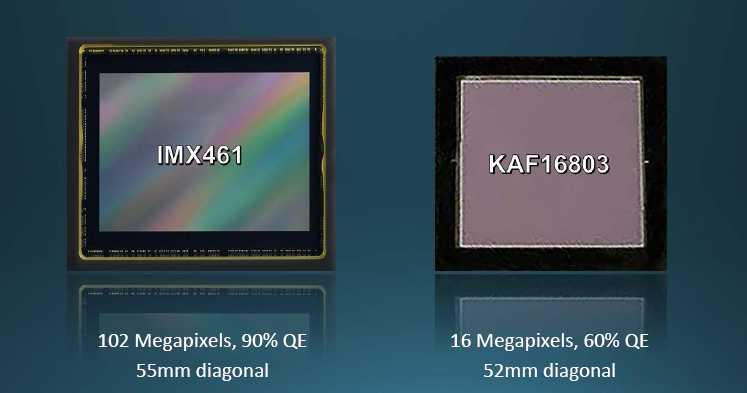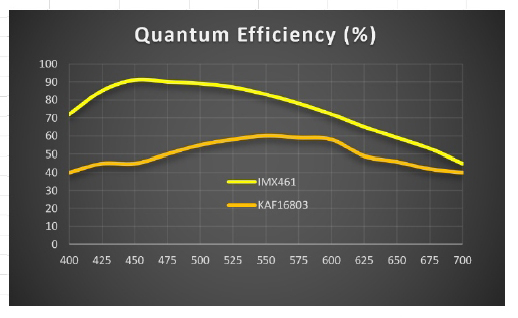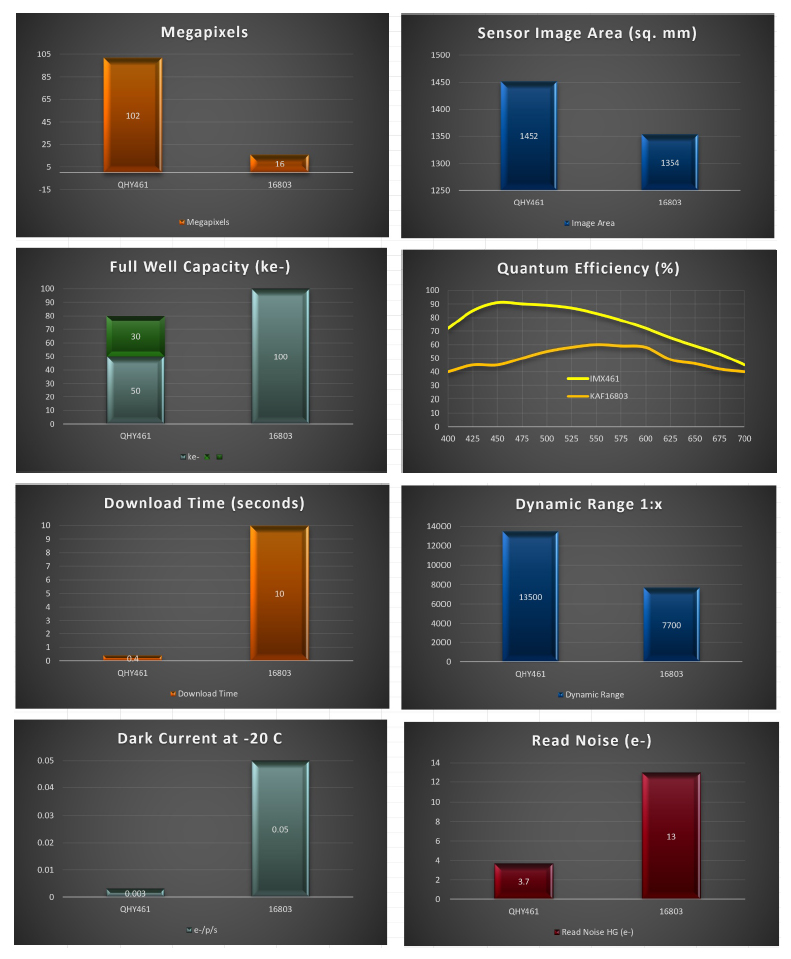Introduction
For several decades monochrome CCD sensors were THE choice for astronomical image acquisition, be it for imaging, astrometric or photometric applications.
At the beginning of the technical development, CCD sensors were much smaller in area than the standard 24 x 35 mm format, but they were much more sensitive and did not suffer from the reciprocity error (the black screen effect), a classical problem of all standard film emulsions. However, CCD sensors were very expensive - initially reserved for professional astronomy - and it took some time before 35mm-sized sensors were available at prices that amateurs could afford. In addition, the pixel dimensions were large (9 µm and larger) and thus hardly usable for short focal length imaging optics.
In the meantime, telescope optics capable of producing high-resolution images over a large field of view (medium format) were further improved, so that sensors with smaller pixel sizes around 4 µm were needed. The production of such CCD sensors with small pixels led to technical problems in the production and besides small pixels were clearly less sensitive (see also keyword: full well capacity) than the usual 9 x 9 µm pixels.
Finally, around 2010, Kodak launched two CCD sensors for digital radiography, the KAF 16803 (with 9 µm pixels) and a larger pixel brother, the KAF-9000. To the benefit of amateur astronomy, these medium format sensors were less expensive than their similarly sized predecessors, so cameras with medium format CCD sensors could be produced for about $10,000 instead of $30,000 or more as before. The KAF 16803 was highly sought after for its 16 megapixel resolution and 36.8 mm x 36.8 mm array. The SBIG company (now Diffraction Limited) was one of the first to market cameras with the KAF 16803 sensor for amateur astronomy. It remained THE dream sensor for serious astrophotographers until recently. It has since been discontinued, as have most of the other commercially available CCD sensors that were once of interest to amateur astronomy. They fell victim to the extensive technological improvements of CMOS sensors, so that today (2023) CMOS sensors are at the forefront of astronomical imaging and have largely supplanted CCD sensors.
The development of CMOS sensors over time has been similar to that of CCD sensors. Initially, CMOS sensors were only available in small sizes, but gradually both quality and size have been increased until today Sony and other CMOS manufacturers are producing large, high-resolution, scientific-grade CMOS sensors that outperform their CCD predecessors in almost every respect. The driver here was clearly the consumer industry - not science - which demanded ever better and cheaper sensors for DSLR cameras, smartphones, dash and webcams, and many other applications.
About 4 years ago (as of 2023), Sony launched two nearly identical scientific CMOS sensors, the IMX 411 and the IMX 461. The only significant difference between the two sensors was the number of pixels.
The IMX 411 has the highest pixel count of all commercially available sensors at 151 Mp. It is still extremely expensive for amateurs, and its 54 mm x 40 mm sensor area also requires filters that are quite expensive, if they are available at all.
The slightly smaller 102-megapixel IMX 461 is based on the same technical-electronic architecture as the IMX 411, and its sensor area still measures 44 mm x 33 mm - significantly larger than full-frame sensors - so it is compatible with commercially available and far less expensive 50 mm square filters. With the development of the new QHY461M Photo, the price is now also comparable to typical KAF 16803 based cameras. Thus, the QHY461M Photo is an ideal successor for all advanced astrophotographers looking for an improved medium format camera to replace their old CCD 16803 models.
Below we describe in detail how the IMX 461 sensor compares to the KAF 16803? What are the main advantages of the new Sony IMX 461 over the Kodak KAF16803?
The sensor - FSI compared to BSI
In sensor technology, a distinction is made between the so-called Back-Side-Illuminated (BSI) and Front-Side-Illuminated (FSI) sensors.
The CCD KAF 16803 is an FSI sensor, while the Sony IMX 461 is BSI CMOS sensor. BSI sensors have several advantages over FSI sensors. These include significantly higher quantum efficiency (QE), higher full well capacitance per square µm (allowing smaller pixel sizes to hold more electrical charge), and thus higher dynamic range than common FSI sensors can achieve. In addition, the CMOS structure developed by Sony has a much lower electrical noise than almost any CCD sensor using FSI technology (see the Analog/Digital Conversion section below).
The pixel size and its resolution
Here, the sensors are quite different. Regardless of whether you consider image resolution as just the ability to resolve detail or as the number of pixels in an image, the IMX 461 far outperforms the KAF 16803. The ability of a sensor to resolve detail is determined solely by pixel size (in µm = 1/1000mm) and shooting focal length. Many current and high quality fast apochromatic refractors or Celestron's RASA telescopes are now capable of illuminating a medium format sensor without vignetting and require much smaller pixels than the KAF 16803 to exploit the required image resolution.
Such telescopes with short focal lengths benefit significantly from smaller pixels for images with the highest spatial resolution. The IMX 461 has more than six times as many pixels as the KAF16803, 102 million versus only 16 million. In addition, the IMX 461 can be binned 2x2 for longer shooting focal lengths to realize 7.5µm pixels, to still have an effective resolution of 25 Mp. This is still 56% more than the KAF 16803 has to offer.
The effective size of the two sensors in direct comparison
The figure shows the relative size of the two sensors in comparison. The figure at the top of this article shows the relative size of the two sensors. The IMX 461 is 44 mm x 33 mm and has an image diagonal of 55 mm. The KAF 16803 is 36.8 mm x 36.8 mm and has an image diagonal of 52 mm. So, for a given focal length, both sensors show roughly the same size image field, with the IMX 461 covering a slightly larger image area.
The noise behavior of both sensors in comparison
The readout noise
At the lowest electronic gain, the IMX 461 achieves a readout noise of only 3.7 electrons (3.7 e-). This is about three times lower than the readout noise of the KAF 16803. At high gain, the noise of the IMX 461 is the remarkable value of nu 1e-, 10 times lower than that of the KAF 16803. Such low readout noise at the highest gain allows the same lens to be imaged with many shorter exposures and their subsequent image addition (stacking) to achieve results comparable to those of a long, single exposure.
The advantages: Much less image loss due to guiding problems with long exposures, plus it becomes possible to sort out individual poorer quality images (seeing) before stacking. Since the readout noise is a fixed value per single exposure - independent of the length of exposure time - shorter exposure times benefit more from sensors with lower readout noise.
The dark current (the dark current noise)
In contrast to readout noise, the dark current increases continuously with the length of the exposure time and can become a dominant noise source at long exposure times. At a sensor temperature of -20 °C, the IMX 461 has a dark current of 0.003 e- per pixel per second. This is about 16 times lower than the dark current noise of the KAF 16803 at the same temperature.
Since dark current noise increases with exposure time, longer exposure times benefit more from cameras with sensors of lower dark current. Therefore, images taken with a QHY461Photo, for example, will contain far less noise than those taken with a KAF 16803, regardless of whether they are exposed shorter or longer.
The quantum efficiency (QE)
The quantum efficiency is, among other parameters, a technical specification that allows a statement about the sensitivity of a sensor. In principle, the value indicates how much incident photons generate an electrical charge in each individual pixel. A value of 100% would mean that EVERY incident photon generates an electric charge. The QE value depends on the wavelength of the light.
The maximum QE of the IMX 461 is 1.5 times higher than that of the KAF 16803 (90% vs. 60%), and its spectral sensitivity is higher across the entire visible spectrum (450 - 700 nm). Therefore, the IMX 461 has not only much lower readout noise and dark current than the KAF 16803, but also higher sensitivity without compensating for pixel size.
The analog - digital conversion (A/D conversion)
Here we have to differentiate between so called 12-, 14- and 16 bit AD converters. High-quality CCD and CMOS sensors convert the electrical charges of the individual pixels into the maximum possible number of 65,536 gray levels (the first CCD-based guiding cameras, such as the legendary SBIG ST4, delivered only 8 bits of data, which corresponds to only 256 gray levels).
The 16 bit AD conversion was developed together with most KAF 16803 based CCD cameras. The IMX 461 also has 16 bit AD conversion. However, it is worth noting that these two sensors differ in the way the analog pixel electrical charges are digitized.
Techtalk:
An essential difference between the two sensor types lies in their technical construction and the readout of the electrical charges of the pixels. In a CCD sensor, first a vertical and then a horizontal transport of the collected electrons takes place via an output line. The signal is digitized centrally in an AD converter, which first converts the number of electrons per pixel into an electrical voltage and then digitizes this voltage value for each individual pixel.
In CMOS sensors, on the other hand, the photodiodes can be addressed and read out individually (each pixel has its own amplifier), since they have both a vertical and a horizontal readout register. The AD conversion takes place separately in each individual pixel of the sensor.
What does this really mean in practice?
In a CCD sensor, the charge that has accumulated in the pixels is first transferred vertically row by row to the last row. The last row is shifted horizontally pixel by pixel, with the charge of each pixel being digitized and passing through a single 16-bit AD converter. Each time the charge is shifted, there is a chance that an error will creep into the signal, amplifying the noise in the image.
However, in a CMOS sensor, such as the IMX 461, not all pixels are processed by just one A/D converter, but each column of pixels has its own AD converter. As the charge is shifted down the column to the converter, noise reduction is performed both before and after AD conversion. This not only speeds up the readout process considerably, but also drastically reduces the readout noise.
When it comes to the speed of reading out an image (download speed in frames per second, fps), the CMOS sensor is clearly ahead. While typically the readout of an image of the QHY 461M PH, BSI Medium Format CMOS Camera, gekühlt (#1931294 , € 12650,-) with 16 bit digitization takes only about 1 second, a KAF 16803 based camera needs more than 10 seconds for this.
The Full Well Capacity and the Dynamic Range of a Sensor
The value of the full well capacity basically indicates how many photons (number of electrons) a single pixel can absorb before it is "full", so to speak (imagine the pixel as a bucket filled with water drops - at some point the bucket is full and overflows. With a high-sensitivity CCD sensor, the ugly blooming streaks on bright stars will then show up).
If the pixel is saturated, an increase of the exposure time does not bring any more signal gain. The full well capacity is given as the number of possible electrons. It is clear that large pixel dimensions allow a higher full well than smaller pixels. The full well capacity of the KAF is about 100ke-. The IMX 461, despite much smaller pixels, still achieves 50 ke- in standard mode and about 80 ke- in extended mode. The IMX 641 reaches full well values of up to 720 ke- in binned mode (4 or 9 pixels are combined into one pixel). However, not only the full well is decisive for the sensor quality, but the so-called dynamic range also plays an important role.
The dynamic range
The term dynamic range of a sensor is usually defined as the value of the full well capacity divided by the readout noise. In simple terms, the value tells how well the sensor is able to simultaneously display very low light and very bright image signals in just a one exposure.
If we take the data of the KAF 16803 sensor, we get a dynamic range of about 1:7000. The IMX 461 achieves a dynamic range of 1:13,500 in standard mode, a value that is almost 1.75 times higher than that of the KAF sensor.
The readout mode
In general, the readout mode of a typical CCD sensor is determined by the designers of the sensor and cannot be influenced by the user. This is the case with most KAF 16803 based cameras. However, Sony offers several readout modes with the IMX 461 that can be easily selected by the user via software when starting the camera driver. One mode, for example, expands the full well capacity from 50,000 e- to about 80,000 e- with 1x1 binning. Otherwise, any of the four read modes can be selected when the camera is connected to optimize readout noise, gain, and/or dynamic range for a particular type of imaging.
The download speed (frame rate)
The download time - also referred to as frame rate - indicates how much time is required to read an image from the sensor and transfer it to the PC. The specification is frame per second (fps). Due to the structural design of the CMSO sensor (see also under the term AD conversion), the CMOS sensor is far ahead of the KAF 16803. The frame rate for a full frame with 102 Mp and 16 bit AD conversion of the IMX 461 is about 0.75 seconds per frame. The KAF needs about 9 seconds for one frame at 16 Mp and 16 bit AD conversion. It should be noted that the 9 seconds refers to a USB 2.0 interface.
So the speed at which the sensor is read out also contributes to productivity, especially when shooting multiple short exposures. In addition, CMOS sensors offer the option of reading out only parts of the sensor that are freely selected by the user. This makes it possible to achieve frame rates of well over 100 frames per second, as required for "lucky imaging" of the sun, moon and planets.
Summary
It is clear from the above that the Sony CMOS sensor IMX 461 not only outperforms the KAF 16803 CCD sensor in virtually all major specifications, but that the
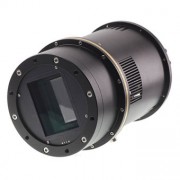 QHY 461 M/C PRO, BSI Cooled Scientific Cameras
QHY 461 M/C PRO, BSI Cooled Scientific Cameras (various versions available)
for example, or even the new
QHY 461 M/C PRO, BSI Cooled Scientific Cameras
QHY 461 M/C PRO, BSI Cooled Scientific Cameras (various versions available)
for example, or even the new
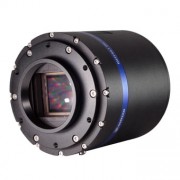 QHY 461M PH, BSI Medium Format CMOS Camera, gekühlt
QHY 461M PH, BSI Medium Format CMOS Camera, gekühlt (#1931294, € 12650,-)
, are also capable of adjusting gain, readout noise, and full frame mode to meet the requirements of a wide variety of imaging situations, making the camera a more flexible instrument. The IMX 461 is nothing less than a quantum step forward in astronomical image acquisition and should be the first choice when an older CCD camera needs to be replaced with a new model.
QHY 461M PH, BSI Medium Format CMOS Camera, gekühlt
QHY 461M PH, BSI Medium Format CMOS Camera, gekühlt (#1931294, € 12650,-)
, are also capable of adjusting gain, readout noise, and full frame mode to meet the requirements of a wide variety of imaging situations, making the camera a more flexible instrument. The IMX 461 is nothing less than a quantum step forward in astronomical image acquisition and should be the first choice when an older CCD camera needs to be replaced with a new model.
Here are the most important technical data of the two sensors in direct comparison
| Specification | Typical KAF 16803 Camera | QHY461 PH |
| Sensor | KAF16803 CCD | Sony IMX461 CMOS |
| Type | Front-Illuminated | Back-Illuminated |
| Pixel Size | 9 µm | 3.76 µm |
| Resolutions | 4096 x 4096 | 11760 × 8896 |
| Total Pixels | 16 Megapixel | 102 Megapixel |
| Sensor Size | 37mm x 37mm | 44mm x 33mm |
| Sensor Size Diagonal | 52 mm | 55 mm |
| Read Noise | 13e- | 1e- to 3.7e- |
| Dark Current | 0.05e- bei -20°C | 0.003e- bei -20°C |
| QE at 450nm | 45% | 90% |
| QE at 550nm | 60% | 83% |
| QE at 650nm | 46% | 59% |
| A/D | 16-bit | 16-bit |
| Full-Well- | 100ke- | 50ke-/80ke- |
| Dynamic Range | 1:7,700 | 1:13,500 |
| Full Frame Download at 16 Bit | 9 Sekunden pro Bild | 0.77 Sekunden pro Bild |
| User Selectable Read Modes | 1 | 4 |





